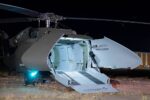The Royal Navy and Indian Navy have conducted their first-ever combined carrier operations in the Arabian Sea, marking a significant step forward in bilateral defense cooperation and maritime interoperability. The joint maneuvers featured the UK’s HMS Queen Elizabeth and India’s INS Vikrant operating together as part of a coordinated Carrier Strike Group (CSG) framework.
Carrier Interoperability Comes of Age
This historic event took place during the ongoing Konkan Shakti 2025 exercise series — a bilateral maritime engagement that has steadily evolved over the past decade. For the first time, both navies deployed their flagship aircraft carriers to conduct synchronized flight operations. The drills included cross-deck aircraft movements, coordinated air tasking missions, anti-submarine warfare (ASW) exercises, and joint command-and-control scenarios.
HMS Queen Elizabeth operated its embarked F-35B Lightning II stealth fighters from 617 Squadron RAF alongside rotary-wing assets including Merlin HM2 helicopters for ASW roles. Meanwhile, INS Vikrant deployed MiG-29K multirole fighters and Kamov Ka-31 AEW helicopters. While no cross-decking of fixed-wing aircraft occurred due to platform incompatibility (STOVL vs STOBAR), both navies executed synchronized launch-and-recovery cycles to simulate integrated air tasking orders (ATO).
Strategic Significance for Indo-Pacific Security
The joint carrier operations underscore growing strategic alignment between London and New Delhi amid rising concerns over maritime security in the Indo-Pacific. As China expands its naval footprint across the Indian Ocean Region (IOR), both nations are increasingly focused on freedom of navigation operations (FONOPs), sea lane security, and regional deterrence.
UK Defense Secretary Grant Shapps emphasized that “the ability of our two navies to operate side-by-side at this level demonstrates not only mutual trust but also a shared commitment to upholding international maritime norms.” Indian Defence Minister Rajnath Singh echoed similar sentiments during his recent visit to Portsmouth Naval Base earlier this year.
This evolution comes on the heels of the UK’s Integrated Review Refresh 2023 which reaffirmed Britain’s ‘tilt’ toward the Indo-Pacific—a strategy that includes deeper defense ties with India as a key pillar. For India, these exercises reinforce its role as a net security provider in the IOR under its SAGAR (Security And Growth for All in the Region) doctrine.
Technical Challenges Overcome
Executing combined carrier operations between two fundamentally different platforms posed several technical hurdles:
- Flight deck compatibility: HMS Queen Elizabeth supports STOVL F-35Bs using ski-jump assisted takeoff; INS Vikrant uses STOBAR configuration tailored for MiG-29Ks.
- C4ISR integration: Establishing secure data links between British Link-16 systems and Indian proprietary networks required temporary gateway solutions for real-time coordination.
- Aviation fuel standards: Harmonizing JP-5 fuel logistics across platforms necessitated pre-exercise planning to ensure safety compliance.
- Airspace deconfliction: Coordinated Air Tasking Orders (ATO) were developed using NATO-standard formats adapted by Indian planners for compatibility.
The successful execution suggests growing maturity in procedural harmonization—though full tactical data link integration remains aspirational pending future upgrades on both sides.
Bilateral Naval Ties Deepen Beyond Symbolism
This milestone builds upon years of incremental cooperation between the Royal Navy and Indian Navy. Notable prior engagements include:
- KONKAN exercises: Annual bilateral drills since early 2000s focusing on surface warfare and boarding ops.
- PASSEX deployments: Passage exercises involving short-term tactical drills during port visits or transits.
- Liaison officers exchange: Embedded officers aboard each other’s warships during deployments such as CSG21’s visit to Mumbai in July 2021.
- Submarine rescue MoUs: Agreements signed enabling mutual support via UK’s NSRS system if required by India’s submarine fleet.
The latest joint carrier operation marks a qualitative leap from symbolic port calls or scripted maneuvers toward operational-level integration—a capability typically reserved for long-standing alliances like NATO or FPDA frameworks.
The Road Ahead: Toward Greater Maritime Integration
The success of this joint deployment opens doors for more ambitious future collaborations. Potential next steps include:
- Cross-deck helicopter ops: Trials involving Merlin HM2 or Wildcat helicopters landing on INS Vikrant’s deck may be feasible given deck size compatibility.
- Tactical data link integration trials: Future exercises may test Link-Y or CENTRIXS-based gateways to enable near-real-time situational awareness sharing.
- Bilateral CSG deployments with third parties: Trilateral drills involving Japan Maritime Self Defense Force or Australian RAN could expand scope under Quad-plus frameworks.
- MRO collaboration: Shared maintenance support agreements—especially for common helicopter types like MH-60R—could reduce logistical burdens during extended deployments.
The Royal Navy is expected to deploy HMS Prince of Wales to Asia-Pacific waters by late FY2026; similar engagements with INS Vikramaditya or follow-on Indian carriers could further institutionalize such high-end naval integration efforts. For now, this first-of-its-kind dual-carrier operation sets an important precedent—and sends a clear signal about evolving maritime partnerships in an increasingly contested region.










